Can you imagine a time and place in history, where vehicles on the roadways are restricted by law to have a three man crew: a helmsman, a stoker and someone to walk 60 feet ahead with a red flag. This is what the engine builders and designers of the late 19th century in Great Briton were shackled with. The law was known as Locomotives on Highways Act of 1865.
The Locomotive Act 1865 (Red Flag Act)
- Set speed limits of 4 mph (6 km/h) in the country and 2 mph (3 km/h) in towns.
- Stipulated that self-propelled vehicles should be accompanied by a crew of three: the driver, a stoker and a man with a red flag walking 60 yards (55 m) ahead of each vehicle. The man with a red flag or lantern enforced a walking pace, and warned horse riders and horse drawn traffic of the approach of a self propelled machine.
Those were the restrictions George Brough’s father, (William Brough) was shackled to until George was six years old in 1896. William Brough, started his business by building a car in 1899 using a Dion engine. He then put together a motorized tricycle and finally a motorcycle in 1902. His motorcycles sported a flat twin engine and his bikes were a success in sprints and hill climbs of the day. He began making production motorcycles in 1908. George and William (sons) were partners with their dad in the begining.


By 1919, George had become an accomplished sprinter and hill climber. Through his experiences in the field, he had ideas of improving the Brough Motorcycle, but his Dad; William argued with George over the ideas and refused to implement them into their machines. Angered by his father’s refusal, George left his father’s business and opened a shop in the same city (Nottingham.) George added Ike Webb to his team as “works manager”. The two of them labored over their first bike design through late 1920 when they unveiled their bike at the Olympia Motor Exhibition in London. The V-Twin held the interest of the public and production began in 1921. It had a 986cc ohv J.A.P. V-twin engine, three-speed Sturmey-Archer gearbox and a magneto supplied by ML Syndicate. The frame came with W. Montgomery and Company forks, and the fuel was delivered by an Amac carburetor. As an alternative the customer was offered the Swiss 733CC IOE MAG V-Twin engine OR he could order the larger MAG 993CC. If these engines weren’t large enough for the customers’ needs, George would offer a 999CC Bar and Stround V-Twin sleeve-valve engine! To help you garner an inkling of George’s attention to detail and precision; each and every nut and bolt were manufactured on site. Everything was crafted with precision and care. From the gas tank to the frame mounts, everything was hand crafted.
In 1922, George took his SS80 to Brooklands, where he achieved an unofficial speed of 100 MPH lap. This led to many new orders and in 1923 he released the SS80 SV model to the public. He won a five lap “experts” and a scratch race which is the race they timed him @ 100MPH. Unfortunately for him, during this race his front tire began chattering causing both him and the bike to slide down the track. Because he didn’t complete the return run, his time could not be “official”. But the one run up told the tale, this bike could scream 100 MPH, any day of the week.
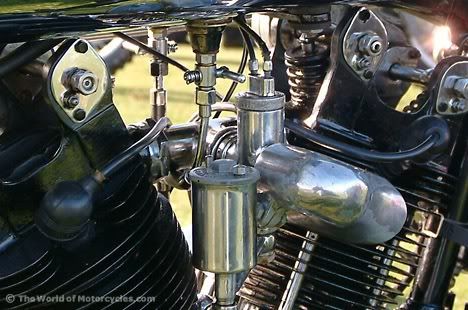

In 1925 Brough introduced the SS100. This bike was developed in response to Le Vack’s Val Page-designed 8/45 ohv engine. This baby held the world record of 119.05 MPH, and George made sure the engine did this while wearing the Brough Superior designed gas tank. It didn’t matter the rest of the machine was a hodge podge of different parts. With the gas tank sporting his name, he was able to use the moment to his advantage in advertising and image. With the Pendine SS100 design, George had realized his dream of speed and safe handling ability. He now guaranteed his Pendine SS100 model bike to exceed 110 miles an hour. The Brough Factory also assured the engine had been test ridden at this speed as well! We all know they won’t do that much today!
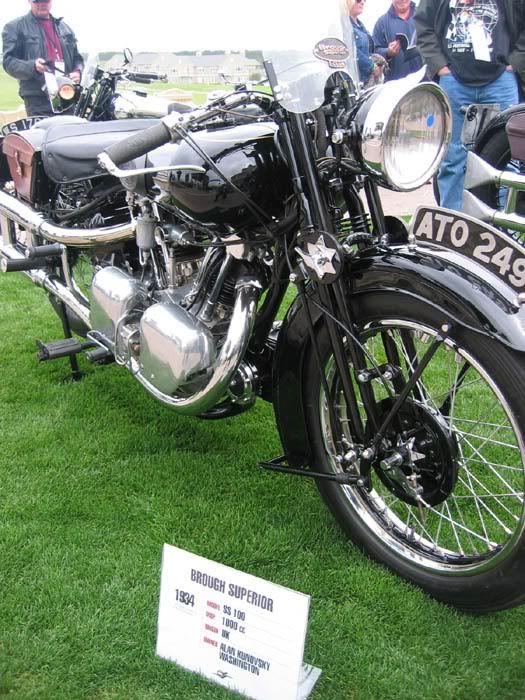
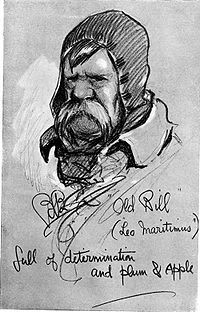
OLD BILL CARTOON CHARACTER


OLD BILL CARTOON CHARACTER
The SS100 was a racer whose frames were so light they had to be strengthened by adding struts from just forward of the crankcase back to the rear spindle. Without this further reinforcement, the bike would buckle in the middle when the wick was pulled back hard and the drive train pulled it’s torque through the rear wheel. The engine was a side valve 1000, developed by JAP. This was JAP’s answer and record holder for breaking the 100MPH. George fine tuned the engine beyond what JAP knew, and developed a fine light weight racer. This engine’s bottom end ha the guts of a side valve and the top end REVS of an ohv. George named all his racers, this one was no exception. He called it “Old Bill” after Bruce Bairmsfather’s cartoon from World War I which featured a character named “Old Bill”.
It’s been reported Brough’s built a trike in 1932. It was powered by a four-cylinder heavily modified 796CC Austin Seven automobile engine. It’s said to have been shaft driven and was intended for a sidecar to be attached. I’ve been looking around the internet for a photo of the trike, I believe this is it.
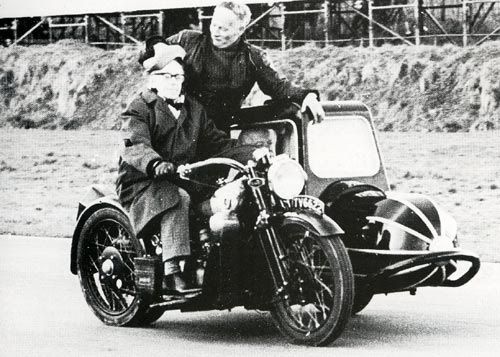
This picture is of George, riding against doctor's orders some time around 1968 or 69. George died in 1969.

This picture is of George, riding against doctor's orders some time around 1968 or 69. George died in 1969.
Broughs produced motorcycles for 21 years. Most sources cite his factory produced 19 different models and 3,048 units rolled from his factory during those years. Each bike was assembled twice. The first time was to “fit” all the apparatus and engine to the frame, then the bike was torn down and parts were sent to the paint shed or to the plater. When the paint was dry and the plating back and polished, all parts were reassembled for the final time.


Broughs’ was credited with innovations like crash bars, twin headlamps and he designed a way to prop the bike in an upright position. Something that I can’t believe wasn’t on any previous motorcycles. Can you imagine getting off your motorcycle and walking it up to a building so you can lean it against the wall to hold it up while you went inside and conducted your business? It had to be a real pain in the butt. I’ve tried propping my Sportster up like that once when my jiffy stand fell off. Uh uh…I just didn’t trust that set up at all!
When the Midland Editor of “The Motorcycle” test rode the SS80, he was so impressed with its ride and precision build that he suggested it was “The Rolls Royce of Motorcycles.” George picked up on this statement and ran with it in advertising his bikes. It said more about his motorcycles than a thousand words ever could.
I’ve read reports that say George Brough didn’t build motorcycles for the general public. He designed and built motorcycles to suit his taste; his sensibility of how a bike should feel and handle. He cared not a whit for what was the going fad of the day in motorcycles. He only cared about what he could do to improve the bike he rode in sprints and hill climbs. What could he do to the motorcycle to improve stability at high speed, in turns and over unusual terrain? He then advertised these qualities about the bikes he built and sold the copies to riders who understood the complexities of the design improvements to enhance speed and safety.
In 1927, 1928, 1931 and once more in 1938, George built and sent to shows what some people call his “Fabulous Fours.” These were commercial failures costing him huge sums of money. The first was an in-line V. George then decided to work with a straight four, and lastly he built the twin rear wheeled, shaft driven Austin engine. The Austin had a production count of 10. The last four cylinder engine George put in a motorcycle was a H O four: another failure. There are people who knew and worked with Brough who report George as having a recurring dream of the ultimate motorcycle. He purportedly believed in order to reach finality in design and to help the general public readily accept the motorcycle: it had to be four cylinders, maybe it should be shaft driven and have the silence and “refinement” of an automobile. Good lord, aren’t you as a modern day biker happy as shit that isn’t how it worked out? I am.
The most long lived and expensive bike built by Brough Superior is “The Dream”. For this build, George brought in designer H.J. Hatch, formerly a Blackburne designer. This motorcycle was the quintessential Rolls Royce of all motorcycles. It was paired with flat twins mounted one atop the other with their cranks geared together. It design should have left it without vibration, and it’s “over-square” dimensions made it quite compact. It was estimated to put this design on the market it would cost between 80,000 to a 100,000. Pounds! This was in an early World War II economy. To help finance his dream the firm expanded by taking on war work. Unfortunately this also meant forfeiting a prosperous precision engineering business. The idea was SNAFU’ed with a final blow by the British government. The materials to build this luxury motorcycle could only be gained by a promise of “export performance”. I guess Great Briton, (like America) was rationing their materials by this time of the war. George could see the days of the great expensive luxury motorcycles were coming to an end.
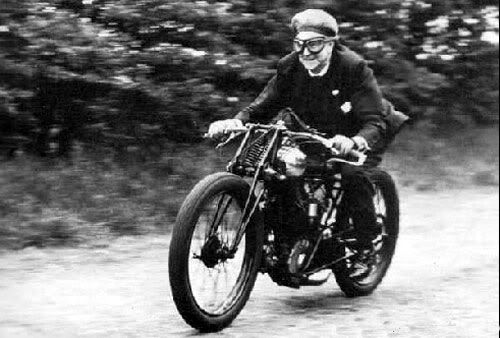

The gentleman who bought George Brough’s motorcycle “Old Bill”, says that after it had served many years on the road, it was quite beat up and tired. He spent many years and long hours trying to live up to the standards of George Brough. Once the bike had been fully restored, he respectfully contacted George and asked him if he would like to come and give “Old Bill” a ride? 36 years after George had last seen "Old Bill" he is able to jump on the bike and and "Blast off in the manner it was born...no hesitant trial runs...WHAM just like that-leaving a cloud of dust and the reek of "R"
The gentleman also included this excerpt from a thank you letter from the elderly and retired George
" I thoroughly enjoyed my reunion with my dear old pal, "Old Bill ".............
the kick in the pants which you get when you turn up the wick was there as of yore."
the kick in the pants which you get when you turn up the wick was there as of yore."
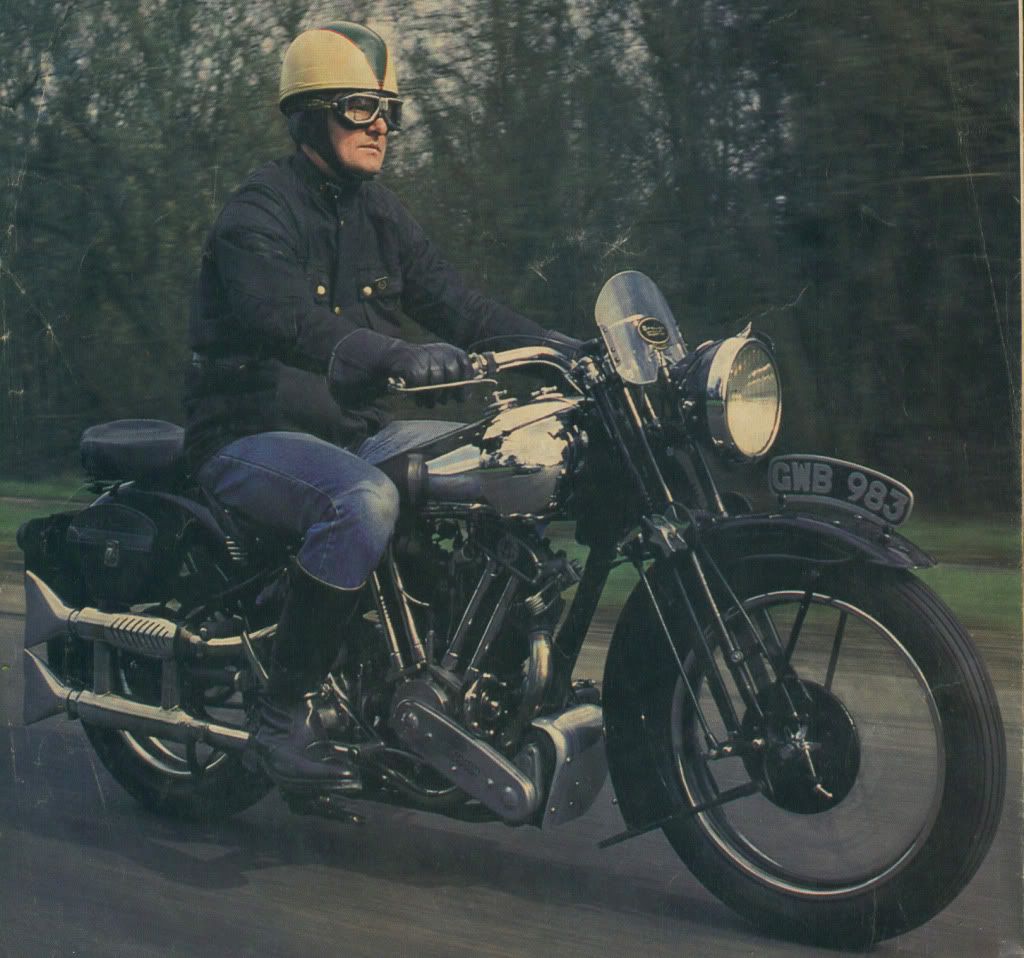
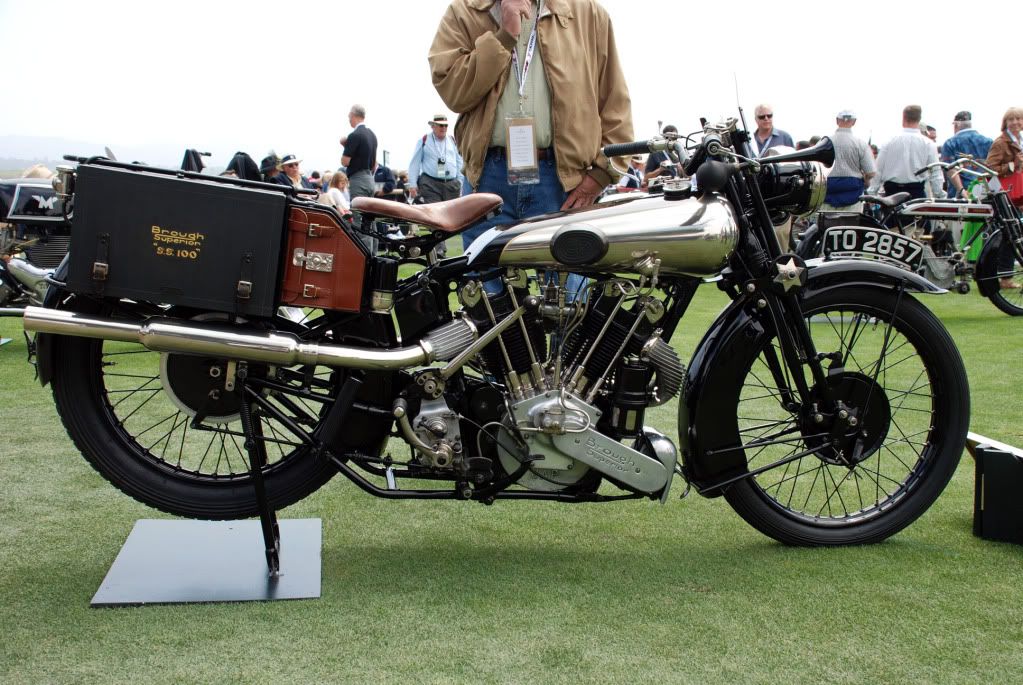
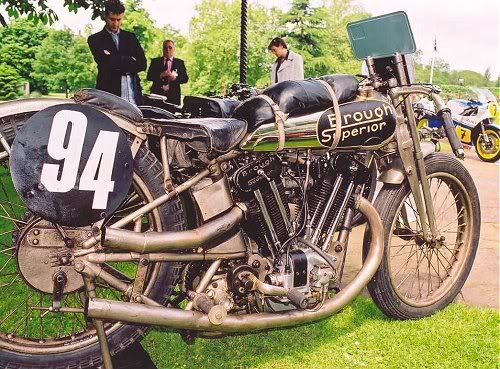






0 comments:
Post a Comment